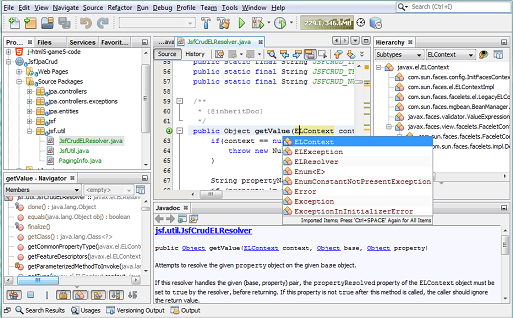
Another way to customize the build is by overriding existing main targets. For list of available properties check the imported nbproject/build-impl.xml file. Builds, tests, and runs the project HelloWorld. Please notice that if you choose other way, the following explanations will not work.ġ. We prefer here to use the Java Project with Existing Sources.
#JAVA NETBEANS HOW TO#
In this section we will show how to use the New Project wizard to create our Scripting Project. home/user_name/./3/user/Scripts/java/HelloWorldĬ:\Documents and Settings\user_name\ApplicationData\\3\user\Scripts\java\HelloWorld Inside this folder you will find the following files:Ĭopy this folder with all its contents inside the user installation directory under opt//basis3.1/share/Scripts/java/HelloWorldĬ:\Program Files\ 3\Basis\share\Scripts\java\HelloWorld $(Office Basis layer)/share/Scripts/java/HelloWorld You can find this example in the share directory of your Office installation under We will use one of the existing examples that come with every installation: HelloWorld.java. In this step-by-step tutorial we will create a NetBeans Project for a Java macro.
#JAVA NETBEANS WINDOWS#
This.getContentPane().add(map,BorderLayout.CENTER) Ĭommenting is not enabled for this article.Finally push the OK button in Options dialog in order to confirm the settings and restart the application (in Windows close also the Quick-starter). This.getContentPane().setLayout(new BorderLayout()) The ID of an ArcGIS Online public Webmap This adds a JMap component to a JFrame, and adds layers from ArcGIS Online to the map. To finish things off, you can build a simple Java app in your project using the following code. In the dialog that opens, choose the new library you created and click ‘Add Library’Īnd… that’s it! You are ready to start building applications or embeddable solutions with the world’s richest and most powerful geospatial API, in one of the world’s most widely-used Java development platforms. In the Categories section, select ‘Libraries’. On the right-hand side of the dialog, click the ‘Add Library’ button. Right-click on your project node in the ‘Projects’ window and open the Project Properties dialog. These jars are located in \sdk\help\api reference\. Optionally, you can configure the Javadoc access for your new ArcGIS Java library by clicking the Javadoc tab and adding the javadoc jars for the ArcGIS Runtme SDK. Select all of these jars and click the ‘Add JAR/Folder’ button. Click on the ‘ Classpath‘ tab in the ANT Library Manager dialog and click the ‘Add JAR/Folder.‘ button. Navigate to the location on disk where your SDK was installed and go further down to the sdk\jars folder. Now, add all of the ArcGIS Runtime SDK Java jar files to your new library. Give the library a name, something like ‘ArcGIS Runtime’.

In the dialog that appears, click the ‘New Library…‘ button in the lower left part of the dialog. In this case, let’s create a new library from scratch that will contain all the jars. This is a good approach if you want that one library to be shared across any of your Netbeans projects.įrom the Netbeans main menu bar, select ‘Tools’ and click ‘ANT Libraries’: There are a number of ways to add the individual ArcGIS jars as library references to your new project. Create a new library to be used in your project Supply a project name, location on disk, and a package and class name of your choice. To create a project, go to File–>New Project and select Java Application from the Java category. We will use an example of creating a basic Java application in NetBeans 7.3 (Beta 2) that displays a Map containing layers of information from an ArcGIS Online Webmap. It is very simple to configure your NetBeans environment for ArcGIS development, and this blog describes these easy steps. The NetBeans IDE is free, open source, and has a worldwide community of users and developers.īecause the ArcGIS Runtime SDK for Java provides a pure Java API and development experience, it plugs in nicely with IDEs such as NetBeans, even though the ArcGIS Runtime SDK does not ship with NetBeans modules. NetBeans also supports mobile and Web development with Java, C++, and many different scripting languages. NetBeans is another great development environment that allows programmers to quickly and easily build great desktop, mobile and web applications with Java.


 0 kommentar(er)
0 kommentar(er)
